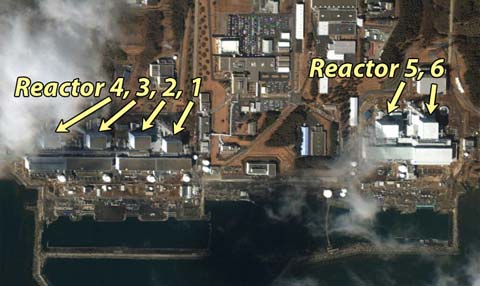The weakness of the Japanese reactor cooling system
Most nuclear reactors in Japan will not achieve stable conditions in case all operating power sources are lost or cut off, even if managers have prepared new backup power sources. or nuclear generators like in the crisis are happening at Fukushima nuclear power plant No. 1.

Location of reactors at Japan's No.1 Fukushima nuclear power plant complex. Photo: CNET .
According to Japan's Kyodo news agency, the possibility of failing to ensure the safety of nuclear reactors in the country of the rising sun is real, since backup power sources are not enough to operate all the necessary equipment. set to keep the reactor cool.
Many reactors in Japan still have no emergency alternative energy sources if diesel generators are not working, as in the case of the Fukushima plant after the earthquake "double" earthquake 9. , 0 richter and tsunami on March 11 last.
The Japanese government's nuclear watchdog has instructed nuclear power management units to be prepared for the possibility of power outages, for example by securing mobile power sources, to prevent another disaster from happening. At Fukushima, the power grid and most emergency diesel generators were completely disabled by earthquakes and tsunamis , resulting in the loss of the critical cooling functions of the reactor.
Ten companies own nuclear plants and the Japan Atomic Energy Agency has announced that it has now deployed electric cars and portable generators. However, sources in the energy industry say, this type of power supply can only run small-scale meters and sprinklers. "They are not enough to be described as backup sources for emergency generators, " said a source.
Only Tokyo Electric Power Corporation (TEPCO) - the Fukushima plant management enterprise - is able to maintain the cooling of four of its operating reactors at the power complex. Kashiwazaki-Kariwa multiplication in Niigata prefecture through the use of a generator with a capacity of 4,500KW and 4 500KW generators.
Among the management enterprises stated that they could not guarantee the backup power source is Japan Atomic Power Company. The company disclosed that it needed about 3,500KW of electricity to maintain safe cooling of the No.2 reactor at Tsuruga power plant in Fukui prefecture, but only deployed a 220KW power generator and a vehicle with a capacity of 800KW.
Meanwhile, in order to announce more consistent information on how Japan is dealing with its worst nuclear disaster, the Japanese government and TEPCO earlier this week held a joint press conference for the first time.The power industry, the government's Nuclear and Industrial Safety Agency, the Ministry of Science and the Japanese Nuclear Safety Commission also held separate press conferences on the incident. However, Goshi Hosono, special adviser to Japanese Prime Minister Naoto Kan, stressed that he wanted to avoid contradiction or overlap of information published by various sources.
On April 27, the International Atomic Energy Agency (IAEA) released the latest assessment of the current state of nuclear safety in Japan. The report of Voice of Russia reported by the IAEA said that the situation at Fukushima No.1 factory is still very serious in general, the radiation levels here have increased to the highest level since the double disaster but there are many signs signs that the factory has recovered some functions. High levels of radiation have caused tens of thousands of people to evacuate from the disaster area.
- Cooling system simulating the circulatory system can replace the air conditioner
- Jellyfish threaten nuclear power plants
- Super-speed 6.700 km / h
- It takes 40 years to close Japanese nuclear power plant
- NASA emergency repair ISS
- Technology to reduce fees and losses after seafood harvest
- The cooling system on ISS is broken
- NASA: Mars nuclear reactor was successfully tested
- Cheap air-conditioned roofs
- Install water cooling system for computers
- Principle of operation of air coolers
- The mystery behind the arc reactor in the Iron Man armor
 Is the magnetic North Pole shift dangerous to humanity?
Is the magnetic North Pole shift dangerous to humanity? Washington legalizes the recycling of human bodies into fertilizer
Washington legalizes the recycling of human bodies into fertilizer Lightning stone - the mysterious guest
Lightning stone - the mysterious guest Stunned by the mysterious sunset, strange appearance
Stunned by the mysterious sunset, strange appearance